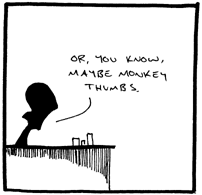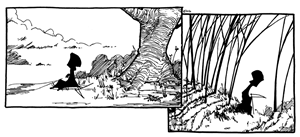As the daily newspaper page becomes an increasingly boring place, original and experimental comic strips have moved to two frontiers: the World Wide Web and the free weeklies. Some occupy both spaces at once. So it is with Elliott G. Garbauskas’ Buttercup Festival, a sweetly sardonic strip that appears in a handful of weekly newspapers and on its own website, where it has attracted a cult following.
The protagonist of the strip looks like Death, although Garbauskas explains on the site that he isn’t – he just wears a black cloak and carries a scythe. The little black figure wanders through an endless series of disconnected gags, many of them nonsensical or based on weirdo shock humor. Not only are the strips separate from one another (there’s no running plot, and only a few recurring characters besides Not-Death), but it’s not uncommon for individual panels in a strip to have no evident correlation.
 Buttercup Festival is least interesting when it goes for the heavily ironic shock humor; some strips seem to exist primarily to demonstrate that Red Meat would not change significantly if the clip art were replaced by little drawings of the Grim Reaper. It’s not that the jokes about characters being killed and skinned or rolling around in feta cheese aren’t funny; it’s just that they’ve been done more effectively elsewhere, and this type of sideshow-geek humor is a little too common on the Web.
Buttercup Festival is least interesting when it goes for the heavily ironic shock humor; some strips seem to exist primarily to demonstrate that Red Meat would not change significantly if the clip art were replaced by little drawings of the Grim Reaper. It’s not that the jokes about characters being killed and skinned or rolling around in feta cheese aren’t funny; it’s just that they’ve been done more effectively elsewhere, and this type of sideshow-geek humor is a little too common on the Web.
But there’s plenty else going on in Buttercup Festival. Sometimes the strip achieves a perfect moment of illogical logic, and sometimes it’s gleefully silly. Gradually, Garbauskas moves away from the Red Meat-esque humor and develops a gentler brand of surreal comedy. The sarcasm of the strip is leavened by a degree of whimsy and wonder. The protagonist’s personality, although never completely consistent, also mellows as the strips progress. Early on, he’s frequently sadistic and sarcastic, the Milkman Dan of his little universe, kidnapping people’s mothers and cruelly endowing windup teeth with consciousness. Later, he’s more of a thoughtful observer, the kind of character who’s not above chasing after a flock of blueberry pancakes and then philosophically watching them fly away. Which is not to say that he won’t still occasionally do horrible things to baby ducklings. Whimsy is a dangerous tool, easily misused, and Garbauskas skillfully balances it with a sharp and wicked wit.
 The strip also grows more visually ambitious. Although most strips consist of simple, nearly-identical black-and-white panels, Garbauskas begins to experiment with color and with more elaborate compositions. He reveals a gift for drawing nature, placing his characters in delicately-rendered woods, fields, and marshes. The protagonist’s relationship with nature becomes a recurring theme in the strip, as he talks to squirrels, bugs, and even raspberries. And sometimes the elegant backgrounds provide ingenious gags, as when God goes fishing or the protagonist accidentally unplugs the forest. Considering the crudeness and extreme simplicity of the drawing in some of the early strips, it’s almost miraculous that "Buttercup Festival" evolves into a comic worth reading just for the art – but it does, it really does.
The strip also grows more visually ambitious. Although most strips consist of simple, nearly-identical black-and-white panels, Garbauskas begins to experiment with color and with more elaborate compositions. He reveals a gift for drawing nature, placing his characters in delicately-rendered woods, fields, and marshes. The protagonist’s relationship with nature becomes a recurring theme in the strip, as he talks to squirrels, bugs, and even raspberries. And sometimes the elegant backgrounds provide ingenious gags, as when God goes fishing or the protagonist accidentally unplugs the forest. Considering the crudeness and extreme simplicity of the drawing in some of the early strips, it’s almost miraculous that "Buttercup Festival" evolves into a comic worth reading just for the art – but it does, it really does.
It’s evident that, for Garbauskas, Buttercup Festival provides a forum in which to experiment with his art, his writing, and the comic-strip format. Inevitably, it’s uneven, switching tone from strip to strip. But there’s beauty, wit, and some damn funny gags in there for those willing to plunge open-minded into Garbauskas’ oddball world.
Shaenon K. Garrity is a staff contributor for Comixpedia. More Details.
As long as we’re talking free weeklies, there are a few interesting strips printed in Boston’s Weekly Dig, especially the racially charged Secret Asian Man.